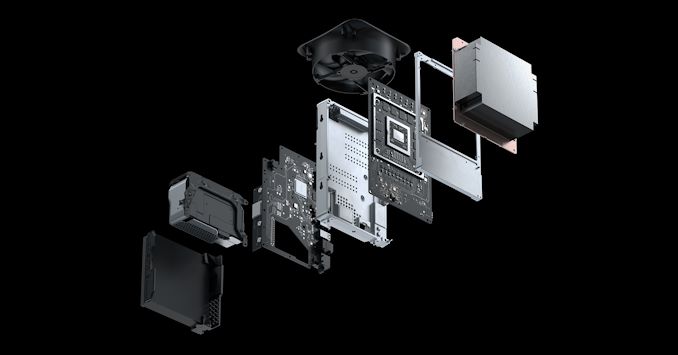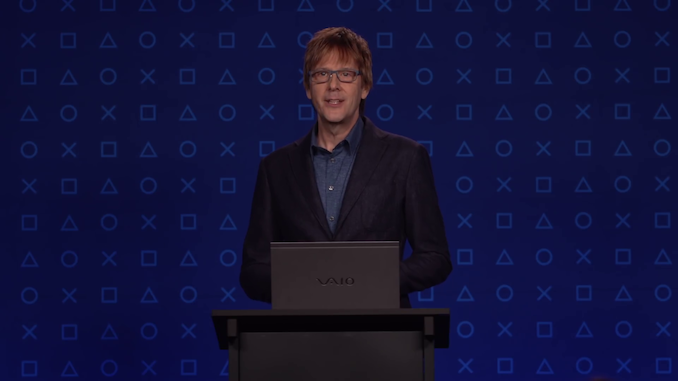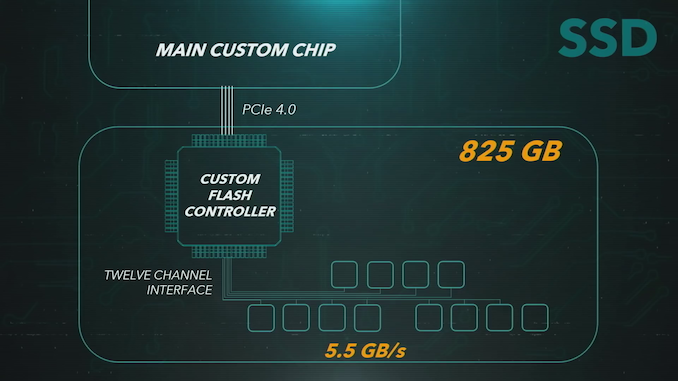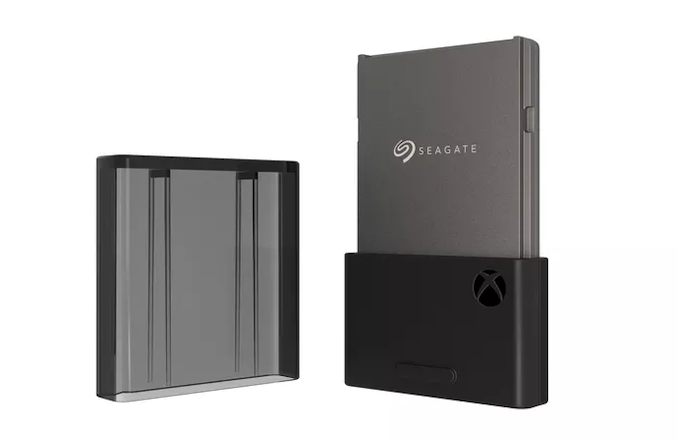Storage Matters: Why Xbox and Playstation SSDs Usher In A New Era of Gaming
by Billy Tallis on June 12, 2020 9:30 AM EST- Posted in
- SSDs
- Storage
- Microsoft
- Sony
- Consoles
- NVMe
- Xbox Series X
- PlayStation 5

A new generation of gaming consoles is due to hit the market later this year, and the hype cycle for the Xbox Series X and Playstation 5 has been underway for more than a year. Solid technical details (as opposed to mere rumors) have been slower to arrive, and we still know much less about the consoles than we typically know about PC platforms and components during the post-announcement, pre-availability phase. We have some top-line performance numbers and general architectural information from Microsoft and Sony, but not quite a full spec sheet.
The new generation of consoles will bring big increases in CPU and GPU capabilities, but we get that with every new generation and it's no surprise when console chips get the same microarchitecture updates as the AMD CPUs and GPUs they're derived from. What's more special with this generation is the change to storage: the consoles are following in the footsteps of the PC market by switching from mechanical hard drives to solid state storage, but also going a step beyond the PC market to get the most benefit out of solid state storage.
Solid State Drives were revolutionary for the PC market, providing immense improvements to overall system responsiveness. Games benefited mostly in the form of faster installation and level load times, but fast storage also helped reduce stalls and stuttering when a game needs to load data on the fly. In recent years, NVMe SSDs have provided speeds that are on paper several times faster than what is possible with SATA SSDs, but for gamers the benefits have been muted at best. Conventional wisdom holds that there are two main causes to suspect for this disappointment: First, almost all games and game engines are still designed to be playable off hard drives because current consoles and many low-end PCs lack SSDs. Game programmers cannot take full advantage of NVMe SSD performance without making their games unplayably slow on hard drives. Second, SATA SSDs are already fast enough to shift the bottleneck elsewhere in the system, often in the form of data decompression. Something aside from the SSD needs to be sped up before games can properly benefit from NVMe performance.
Microsoft and Sony are addressing both of those issues with their upcoming consoles. Game developers will soon be free to assume that users will have fast storage, both on consoles and on PCs. In addition, the new generation of consoles will add extra hardware features to address bottlenecks that would be present if they were merely mid-range gaming PCs equipped with cutting-edge SSDs. However, we're still dealing with powerful hype operations promoting these upcoming devices. Both companies are guilty of exaggerating or oversimplifying in their attempts to extol the new capabilities of their next consoles, especially with regards to the new SSDs. And since these consoles are still closed platforms that aren't even on the market yet, some of the most interesting technical details are still being kept secret.
The main source of official technical information about the PS5 (and especially its SSD) is lead designer Mark Cerny. In March, he gave an hour-long technical presentation about the PS5 and spent over a third of it focusing on storage. Less officially, Sony has filed several patents that apparently pertain to the PS5, including one that lines up well with what's been confirmed about the PS5's storage technology. That patent discloses numerous ideas Sony explored in the development of the PS5, and many of them are likely implemented in the final design.
Microsoft has taken the approach of more or less dribbling out technical details through sporadic blog posts and interviews, especially with DigitalFoundry (who also have good coverage of the PS5). They've introduced brand names for many of their storage-related technologies (eg. "Xbox Velocity Architecture"), but in too many cases we don't really know anything about a feature other than its name.
Aside from official sources, we also have leaks, comments and rumors of varying quality, from partners and other industry sources. These have definitely helped fuel the hype, but with regards to the console SSDs in particular, these non-official sources have produced very little in the way of real technical details. That leaves us with a lot of gaps that require analysis of what's possible and probable for the upcoming consoles to include.
What do we know about the console SSDs?
Microsoft and Sony are each using custom NVMe SSDs for their consoles, albeit with different definitions of "custom". Sony's solution aims for more than twice the performance of Microsoft's solution and is definitely more costly even though it will have the lower capacity. Broadly speaking, Sony's SSD will offer similar performance to the high-end PCIe 4.0 NVMe SSDs we expect to see on the retail market by the end of the year, while Microsoft's SSD is more comparable to entry-level NVMe drives. Both are a huge step forward from mechanical hard drives or even SATA SSDs.
| Console SSD Confirmed Specifications | |||
| Microsoft Xbox Series X |
Sony Playstation 5 |
||
| Capacity | 1 TB | 825 GB | |
| Speed (Sequential Read) | 2.4 GB/s | 5.5 GB/s | |
| Host Interface | NVMe | PCIe 4.0 x4 NVMe | |
| NAND Channels | 12 | ||
| Power | 3.8 W | ||
The most important and impressive performance metric for the console SSDs is their sequential read speed. SSD write speed is almost completely irrelevant to video game performance, and even when games perform random reads it will usually be for larger chunks of data than the 4kB blocks that SSD random IO performance ratings are normally based upon. Microsoft's 2.4GB/s read speed is 10–20 times faster than what a mechanical hard drive can deliver, but falls well short of the current standards for high-end consumer SSDs which can saturate a PCIe 3.0 x4 interface with at least 3.5GB/s read speeds. Sony's 5.5GB/s read speed is slightly faster than currently-available PCIe 4.0 SSDs based on the Phison E16 controller, but everyone competing in the high-end consumer SSD market has more advanced solutions on the way. By the time it ships, the PS5 SSD's read performance will be unremarkable – matched by other high-end SSDs – except in the context of consoles and low-cost gaming PCs that usually don't have room in the budget for high-end storage.
Sony has disclosed that their SSD uses a custom controller with a 12-channel interface to the NAND flash memory. This seems to be the most important way in which their design differs from typical consumer SSDs. High-end consumer SSDs generally use 8-channel controllers and low-end drives often use 4 channels. Higher channel counts are more common for server SSDs, especially those that need to support extreme capacities; 16-channel controllers are common and 12 or 18 channel designs are not unheard of. Sony's use of a higher channel count than any recent consumer SSD means their SSD controller will be uncommonly large and expensive, but on the other hand they don't need as much performance from each channel in order to reach their 5.5GB/s goal. They could use any 64-layer or newer TLC NAND and have adequate performance, while consumer SSDs hoping to offer this level of performance or more with 8-channel controllers need to be paired with newer, faster NAND flash.
The 12-channel controller also leads to unusual total capacities. A console SSD doesn't need any more overprovisioning than typical consumer SSDs, so 50% more channels should translate to about 50% more usable capacity. The PS5 will ship with "825 GB" of SSD space, which means we should see each of the 12 channels equipped with 64GiB of raw NAND, organized as either one 512Gbit (64GB) die or two 256Gbit (32GB) dies per channel. That means the nominal raw capacity of the NAND is 768GiB or about 824.6 (decimal) GB. The usable capacity after accounting for the requisite spare area reserved by the drive is probably going to be more in line with what would be branded as 750 GB by a drive manufacturer, so Sony's 825GB is overstating things by about 10% more than normal for the storage industry. It's something that may make a few lawyers salivate.
It's probably worth mentioning here that it is unrealistic for Sony to have designed their own high-performance NVMe SSD controller, just like they can't do a CPU or GPU design on their own. Sony had to partner with an existing SSD controller vendor and commission a custom controller, probably assembled largely from pre-existing and proven IP, but we don't know who that partner is.
Microsoft's SSD won't be pushing performance at all beyond normal new PC levels now that OEMs have moved beyond SATA SSDs, but a full 1TB in a PC priced similarly to consoles would still be a big win for consumers. Multiple sources indicate that Microsoft is using an off-the-shelf SSD controller from one of the usual suspects (probably the Phison E19T controller), and the drive itself is built by a major SSD OEM. However, they can still lay claim to using a custom form factor and probably custom firmware.
Neither console vendor has shared official information about the internals of their SSD aside from Sony's 12-channel specification, but the capacities and performance numbers give us a clue about what to expect. Sony's pretty much committed to using TLC NAND, but Microsoft's lower performance target is down in the territory where QLC NAND is an option: 2.4GB/s is a bit more than we see from current 4-channel QLC drives like the Intel 665p (about 2GB/s) but much less than 8-channel QLC drives like the Sabrent Rocket Q (rated 3.2GB/s for the 1TB model). The best fit for Microsoft's expected performance among current SSD designs would be a 4-channel drive with TLC NAND, but newer 4-channel controllers like the Phison E19T should be able to hit those speeds with the right QLC NAND. Either console could conceivably in the future get a double-capacity version that uses QLC NAND to reach the same read performance of the original models.
DRAMless, but that's OK?
Without performance specs for writes or random reads, we cannot rule out the possibility of either console SSD using a DRAMless controller. Including a full-sized DRAM cache for the flash translation layer (FTL) tables on a SSD primarily helps performance in two ways: better sustained write speeds when the drive's full enough to require a lot of background work shuffling data around, and better random access speed when reading data across the full range of the drive. Neither of those really fits the console use case: very heavily read-oriented, and only accessing one game's dataset at a time. Even if game install sizes end up being in the 100-200GB range, at any given moment the amount of data used by a game won't be more than low tens of GB, and that is easily handled by DRAMless SSDs with a decent amount of SRAM on the controller itself. Going DRAMless seems very likely for Microsoft's SSD, and while it would be very strange in any other context to see a 12-channel DRAMless controller, that option does seem to be viable for Sony (and would offset the cost of the high channel count).
The Sony patent mentioned earlier goes in depth on how to make a DRAMless controller even more suitable for console use cases. Rather than caching a portion of the FTL's logical-to-physical address mapping table in on-controller SRAM, Sony proposes making the table itself small enough to fit in a small SRAM buffer. Mainstream SSDs have a ratio of 1 GB of DRAM for each 1 TB of flash memory. That ratio is a direct consequence of the FTL managing flash in 4kB chunks. Having the FTL manage flash in larger chunks directly reduces the memory requirements for the mapping table. The downside is that small writes will cause much more write amplification and be much slower. Western Digital sells a specialized enterprise SSD that uses 32kB chunks for its FTL rather than 4kB, and as a result it only needs an eighth the amount of DRAM. That drive's random write performance is poor, but the read performance is still competitive. Sony's patent proposes going way beyond 32kB chunks to using 128MB chunks for the FTL, shrinking the mapping table to mere kilobytes. That requires the host system to be very careful about when and where it writes data, but the read performance that gaming relies upon is not compromised.
In short, while the Sony SSD should be very fast for its intended purpose, I'm going to wager that you really wouldn't want it in your Windows PC. The same is probably true to some extent of Microsoft's SSD, depending on their firmware tuning decisions.
Expandability
Both Microsoft and Sony are providing expandability for the NVMe storage of their upcoming consoles. Microsoft's solution is to re-package their internal SSD into a custom removable form factor reminiscent of what consoles used back when memory cards were measured in MB instead of TB and before USB flash drives were ubiquitous. Since it uses all the same components, this expansion card will be functionally identical to the internal storage. The downside is that Microsoft will control the supply and probably pricing of the cards; currently Seagate is the only confirmed partner for selling these proprietary expansion cards.
Sony is taking the opposite approach, by giving users access to a standard M.2 PCIe 4.0 slot that can accept aftermarket upgrades. The requirements aren't entirely clear: Sony will be doing compatibility testing with third-party drives in order to publish a compatibility list, but they haven't said whether drives not on their approved list will be rejected by the PS5 console. To make it onto Sony's compatibility list, a drive will need to mechanically fit (ie. no excessively large heatsink) and offer at least as much performance as Sony's custom internal SSD. The performance requirements mean no drive currently available at retail will qualify, but the situation will be very different next year.














200 Comments
View All Comments
PeachNCream - Friday, June 12, 2020 - link
What makes a console a good piece of hardware is that I do not have to even care what is inside the box that runs the games since the games that I buy for said console will just work as intended. Every generation has extensive discussion about hardware and the usual comparing and penis measuring between brands. It all ends up being meaningless when you pick up a controller and play a game on it which is far and above the hassle of PC gaming in terms of equipment apathy. In short, IDGAF what drive is inside the thing. Insert disc (or download digital copy) and game on!shabby - Friday, June 12, 2020 - link
Games will work just as intended? Are you suggesting console games never suffer from fps dips below 30fps or have lower quality graphics to hit 30fps?close - Friday, June 12, 2020 - link
If you played on both console and PC then you know what that means. I do that and yes, on the console it's a lot more hassle-free. Every game is optimized for *that* configuration, perhaps with minor variations between the 2-3 cycle refreshes. No need to worry about "does it work better on the Radeon? Should I use the older driver? Adjust graphics settings to determine which one has the best graphics for *your* PC. Etc. It extracts the most out of that hardware.On my PC (with a far better config than any console) Assassin's Creed Odyssey freezes for a second (not a figure of speech) every once in a while even if it runs flawlessly otherwise. On the Xbox it works just fine. On the PC I had to adjust graphics because the highest level was just a tad too much but the next lower level left too much performance on the table, so I had to tweak a full screen (or 2) of settings about shadows, aliasing, and whatnot to get "the best for my setup". Maybe. I don't know, I can't be bothered to spend half a day experimenting. Now subjectively it looks better on the Xbox with a 4K screen than on the PC with a 1440p screen.
On the other hand it also means 5 years from now you have an old GPU that you can't swap out. But for console gamers that's a small price to pay.
Retycint - Saturday, June 13, 2020 - link
You don't need to adjust the graphics configuration or mess with drivers because the option has been taken away from you. Instead of having the choice to slightly lower texture quality to ensure smooth gameplay, for instance, the game devs decide that a dip below 30fps is acceptable and push it onto you.Very strange to describe the lack of choices as "it just works"
PeachNCream - Saturday, June 13, 2020 - link
That's a pretty weak argument that doesn't take anything away from the original point of not having to care about the underlying hardware and being assured that a game purchased for a particular console will work properly on said console.vol.2 - Saturday, June 13, 2020 - link
"will work properly" is what people are taking issue with. the argument is that there are games that run crappy on consoles. don't try to pretend that there haven't been plenty of prime examples over the past 10 years or so of games that are poorly optimized for consoles.On a PC, when that happens, you tweak settings until it's playable. On a console you have a shitty experience. Or maybe you just don't care for whatever reason. That's the point. Is a deal breaker for you, I guess not. It is for some.
close - Sunday, June 14, 2020 - link
I find this suspicious given that I play on both platforms and if anything, games are optimized *for consoles*. From performance, to gameplay, and controls. Devs make *a lot* more money from console sales since piracy is pretty much non existing so it makes sense they'd focus on them.As an anecdote I found far, far more games misbehaving on PC than on the Xbox. Between driver issues, "optimized for the that other hardware that you don't have" issues, trying to balance all the setting (most of which most people have no idea about), auto detect settings that "guess" what you should use based on some too simplistic checks, and basic game bugs I faced more problems on the PC. Yes, there are issues on consoles but the argument "well you have issues on both therefore the experience must be the same or worse on consoles" comes almost exclusively from people who "read about it", "heard from someone", etc. but never actually tried both for any meaningful period of time.
Yes, for all intents and purposes games "will work properly" and with less hassle on consoles in more cases than on the PC. And I say this as someone who can definitely handle whatever a computing system can throw at them better than 99.9999% of the population. But that doesn't mean I *want* to have to handle that, especially on what's supposed to be my fun, hassle free time.
Not trying to convince you to use either but if if you want to share your opinion the least you can do is be fully informed.
hecksagon - Sunday, June 14, 2020 - link
Couple counter arguments here.Just because the console game works as intended doesn't mean it doesn't run like shit. No developer ever wanted its fans to play their game at 30fps, just like no developer wanted their fans to play their game at 720p. Unfortunately with consoles its always been compromise. You either optimize for image quality or optimize for steady gameplay, or meet somewhere in-between.
hecksagon - Sunday, June 14, 2020 - link
Apparently I'm too stupid to find the edit button.The other point is that PCs, while more complicated, offer expanded options thanks to that complication. Want high refresh rate gaming? Not gonna get it on a console not only due to performance but due to HDMI limitations. Want to play an RTS? Good luck with a controller. Want an extra wide monitor to handle that increased FOV you are playing at? Your resolution isn't supported on consoles. VR? Don't waste your time with a console. Modding games? Gonna get you banned on a console. Emulation? Not likely on a console, better go get yourself a Playstation Mini.
lunarx3dfx - Monday, June 15, 2020 - link
I think what we have here is a classic case of one screen and two different movies. One argument is being made on subjective experience, and the other is being made from an objective point of view. I could be wrong, but I don't think OP is stating that consoles are more powerful, but more the subjective opinion that the just download game and play is more convenient for them and for a lot of people.As a dad I can understand this sentiment, which is why since my daughter was born I too have spent more time gaming on console. I find the lack of choice when it comes to performance settings as a bonus because I am that person who, if given the choice, will spend ages tweaking settings to get the best image quality at 60 fps. This however resulted in the limited amount of time I have available to play games being eaten up by time spent tweaking.
In contrast, on my Xbox I just download the game and play. Is it an objectively better experience than running the game at maxed out settings on a PC at 60+ fps? No. Not at all. But the convenience is a factor in my overall enjoyment these days. However, there are some types of games I will NEVER play on a console. Doom for isntance. That is a PC only game in my eyes. You just can't beat a keyboard and mouse for that game. Period.
I think where this argument always ends up coming from is personal opinion based on what is important to the end user. PCs are so much easier to build, setup, and play games on than in the 80's and 90's when I first got into PC gaming, but for many users it's still intimidating. That's why the console market is so large, and will continue to be. At the end of the day, many consumers still prefer the ease of setup and use that consoles afford, and you can't really put a price on that. A lot of people want to just take the machine out of the box, plug in two cables, download a game, and get playing.